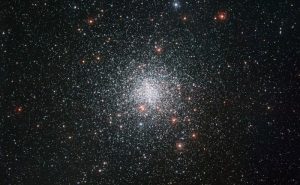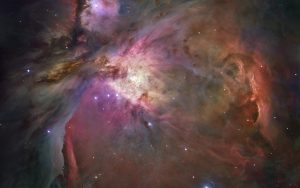(Note: This blog post turned out to be more than twice as long as my usual posts so I’ve split it into two. This is Part 1 and Part 2 will follow immediately.)
We’ve had some really clear skies here in Philadelphia the last few nights, just perfect for stargazing. Two nights ago I spent a good hour observing the four planets that are visible during the evening right now, Venus, Mars, Jupiter and Saturn. However last night I wanted to see some deep space objects. Star clusters, Nebula and Galaxies.
Problem is that the light pollution inside the city is so intense that you simply can’t see anything that faint. Oh, the planets and a few of the brighter stars are easy enough to see if you can just get away from the streetlights but the fainter, more interesting objects, well just forget it.

So I drove over to New Jersey, halfway to the ocean in fact, to a spot I know of where I can get some ‘Dark Sky’. After letting my eyes adjust I could see thousands of stars along with the Milky Way. Taking out my binoculars I spent the next hour observing seven of the objects from Charles Messier’s catalog.
What’s Messier’s catalog you ask? Well, let me tell you.
Born in 1730 Charles Messier was the son of a minor member of the French Court. Inspired by a very spectacular ‘seven tailed’ comet in 1744 Charles got a job working at the French Naval Observatory, in those days astronomy was very important in navigating around the globe. The image below is of Charles Messier.

At that time the cutting edge of astronomical research was comets. Using Newton’s law of gravity Edmund Halley had predicted in 1705 that the comet now named for him would return in 1758 and when it did all of Europe went comet crazy. During his lifetime Charles Messier is credited with the discovery of thirteen comets.
As Messier spent night after night searching for comets he often came across fuzzy, comet-like objects that didn’t move against the fixed stars as a comet would. Remember, comets may have very long, stretched orbits around the Sun, but they still orbit the Sun, they still move against the background of fixed stars. Anyway, rather than being constantly sidetracked by these comet-like objects Messier began to compile a catalog of them so that he, and other astronomers could ignore them.
Messier published the ‘final’ version of this list in 1784 with 103 objects cataloged. After Messier’s death in 1817 however researchers going through his notes found that he had discovered another seven objects so astronomers now recognize 110 objects as Messier objects.
Funny thing is, Messier complied his catalog so that he wouldn’t be distracted from his comet search by them. Today however astronomers are far, far more interested in the Messier objects than they are by comets. Messier objects come in six main types; open star clusters, globular cluster, gaseous nebula, planetary nebula, supernova remnants and finally galaxies. I’ll discuss each type using a well known example from Messier’s catalog.
Open Star Clusters (M45 the Pleiades): The easiest Messier object to find is the cluster of stars known as the Pleiades or ‘Seven Sisters’ that form a very small dipper on the back of Taurus the Bull. Although six or seven stars are visible with the naked eye binoculars will show over twenty and a good telescope reveal more than a hundred. The image below shows the Pleiades with the seven sisters named but you can easily see that there are many other stars in the group as well.

We now know that an Open Star Cluster is what happens when a gas cloud that has given birth to several hundred or even a thousand stars is dissipated by the energy being given off by those young stars. If the gas cloud is the stellar nursery then the open cluster is the star’s kindergarten. For several million years the stars in a cluster will travel together around the milky way but in time the gravitational pulls of the rest of the galaxy causes the stars apart to drift apart. So open clusters only last for a short period of time. Four and a half billion years ago our Sun must have been in an open cluster but the Sun’s brethren are now long gone.
Globular Clusters (M4, Globular Cluster near the star Antares): M4 may not be the biggest Globular Cluster but I’ve always considered it to be the easiest to find because it is so near Antares, the bright red heart of the constellation Scorpio. The name Antares means the rival of Mars and because of the star’s position near the plane of the ecliptic the planet and star do sometimes come close enough to rival each other. Once you find Antares look with binoculars just a short distance to the left and you’ll see a very pale, faint cotton ball. That is the globular cluster M4. See image below.

Globular Clusters are quite mysterious and very ancient. Containing hundreds of thousands or more than a million stars globular clusters last for billions of years. In fact it appears that many of the globulars in and around the Milky Way are actually older than the Galaxy is. Some astro-physicists speculate that globular clusters are the building blocks that form galaxies but in that case, how do globular clusters form?
Gaseous Nebula (M42, The Orion Nebula): We now know that gaseous nebula are in fact the gas clouds where stars are formed. The Hubble and other space telescopes looking into gaseous nebula in the infrared spectral region have now learned much about how stars form in such gas clouds. The Orion Nebula is a very easy example of a gaseous nebula to spot because I think the constellation of Orion is one of the easiest to spot. Once you’re found Orion look for the three stars of his belt. The Orion Nebula is just a short distance below the middle star of the belt. See image below.

I’m going to end for today right here. I’ll discuss the last three types of Messier objects in Part 2 of this post coming soon.
